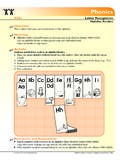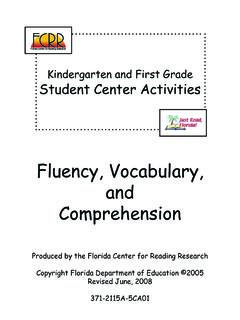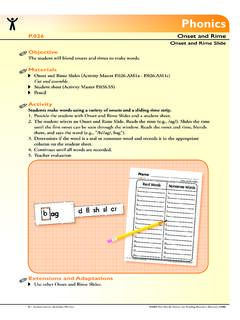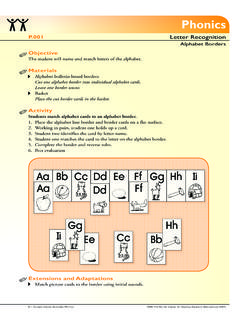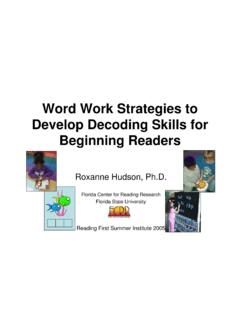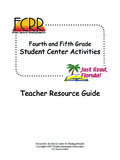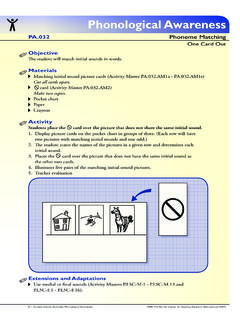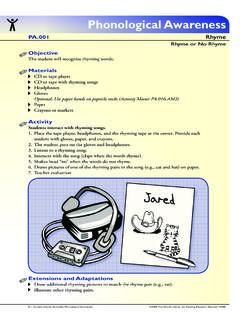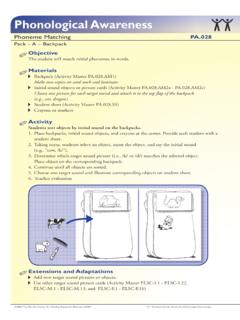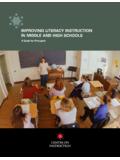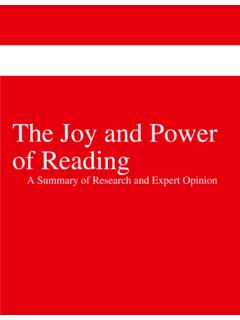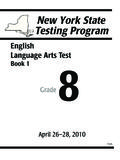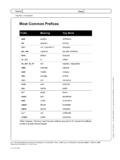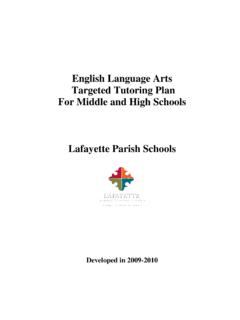Transcription of Kindergarten and First Grade Student Center …
1 Produced by the florida Center for reading ResearchCopyright florida Department of Education 2005371-2115A-5CA01 Teacher Resource GuideKindergarten and First GradeStudent Center Activities2005 The florida Center for reading ResearchTeacher Resource GuideK-1 Student Center Activities: Teacher Resource GuideWe would like to thank the following individuals and organizations for their contributions to this Read, florida ! Office at the florida Department of EducationMary Laura Openshaw, Free, Development Team at FCRRM arcia Kosanovich, Keaton, Logan, Magill, Stafford, Review Team at FCRRG eorgia Jordan, Rissman, Van Sciver, Wahl, Projects Group at FCRRKarl Hook, Lenkway, Bice, Brooke, Ziglar, ArnoldFCRR Senior StaffJoseph Torgesen, R. Brown, , , Kosanovich, Howard, Hook, Nettles, Curran, SupportScholastic The florida Center for reading ResearchTeacher Resource GuideK-1 Student Center Activities: Teacher Resource GuideIntroductionDuring the Spring 2004 florida reading First school site visits, staff from the florida Center for reading research (FCRR) determined that teachers may benefit from classroom materials that would be immediately useful in implementing independent Student Center 2004-2005, a team of teachers at FCRR collected ideas and created materials for use in Kindergarten and First Grade classrooms.
2 There are three books: 1. Phonological Awareness and Phonics Student Center Activities 2. Fluency, Vocabulary, and Comprehension Student Center Activities 3. Teacher Resource GuideThe First two books are activity plans and activity masters ready for immediate use in classrooms. The third book is an informative guide offering important insight on differentiated instruction and how to use the Student Center materials. When considering florida s formula, 5 + 3 + ii + iii = No Child Left Behind, please note that each instructional component is covered in the Student Center activities books. In addition, the activities will directly support your efforts to provide effective initial instruction, because they will help you to provide differentiated instruction to meet the needs of every Student Center Activities, Teacher Resource Guide, and accompanying Professional Development DVD can be accessed online at hope you and your students enjoy these activities,Marcia L.
3 Kosanovich, of Curriculum and Instructional ProjectsFlorida Center for reading Research2005 The florida Center for reading ResearchTeacher Resource GuideK-1 Student Center Activities: Teacher Resource Guide2005 The florida Center for reading ResearchTeacher Resource GuideK-1 Student Center Activities: Teacher Resource GuideFive Components of reading Instruction Phonological Awareness Phonics Fluency Vocabulary ComprehensionFrequently Asked Questions What is differentiated instruction? What is a reading Center ? How are these reading Center activities different from Centers of the past? Why are these reading Centers and not Literacy Centers? Can other, more traditional centers be used? What are examples of reading Centers and Activities?Implementing and Managing Student Centers in the Classroom Form Flexible Groups Based on Assessment Identify Appropriate Center Activities Based on Assessment Design Center Management System Implement a Behavior Management System Give Explicit Center Directions Organize the Classroom Manage Transitions Establish AccountabilityInterpretation and Implementation of Activity Plans Overview Provide Consistent Materials Preparing a Computer Center Guidelines for Effective Computer Centers Selecting Quality Computer Software and Technology-based Curricula Materials Materials Needed for K-1 Student Center ActivitiesCrosswalk Activity Number & Subcomponent DIBELS Measures Kindergarten Grade Level Expectation First Grade Level ExpectationGlossary1
4 7 1133 45 75 Table of Contents2005 The florida Center for reading ResearchTeacher Resource GuideK-1 Student Center Activities: Teacher Resource Guide2005 The florida Center for reading ResearchTeacher Resource GuideK-1 Student Center Activities: Teacher Resource Guide1 The Five Components of reading InstructionResearch has made great strides in identifying critical skills that consistently relate to reading success. Based on a comprehensive review of reading research , the Report of the National reading Panel (2000) concluded the need for systematic and explicit instruction in the following five components of reading : Phonemic Awareness Phonics Fluency Vocabulary Comprehension Considered core elements of successful classroom reading instruction, these five components are a fundamental part of the reading First Initiative, which is the reading portion of the No Child Left Behind Act.
5 reading programs that are aligned with current reading research include systematic and explicit instruction in the five components. Systematic instruction is the direct presentation of skills/concepts in a pre-specified sequence taught in a logical, defined order. For example: Skills and concepts begin with the most simple and move to the most complex Student objectives are clear, concise, and driven by ongoing assessment results students are provided with appropriate practice opportunities which directly reflect instruction Explicit instruction is taught directly through teacher modeling, guided practice, and independent practice. For example: Teacher models and explains Teacher provides guided practice- students practice what the teacher modeled and the teacher provides prompts and feedback. Teacher provides supported application- students apply the skill as the teacher scaffolds instruction Independent practiceThis section of the Teacher Resource Guide accompanies the Kindergarten and First Grade (K-1) Student Center Activities developed by the florida Center for reading research .
6 It is designed to assist teachers in implementing the independent Student Center activities that support skill building in each of the five components. Each of the following sections includes a definition, a goal, and a brief description of how the K-1 Student Center Activities support growth in each of the five components. 2005 The florida Center for reading ResearchTeacher Resource GuideK-1 Student Center Activities: Teacher Resource Guide2 The Five Components of reading InstructionPhonological AwarenessPhonological Awareness is defined as one s sensitivity to, or explicit awareness of, the phonological structure of words in one s language. It encompasses an awareness of individual words in sentences, syllables, and onset and rime segments as well as awareness of individual phonemes in words. Phonological Awareness is considered an umbrella or broad term, which covers aspects of sound identification and manipulation in spoken language.
7 Activities in Phonological Awareness are based on a progression of skill difficulty ( , rhyme, alliteration, sentence segmentation, syllable, onset and rime, and phonemes). The goal of Phonological Awareness instruction is to develop an awareness that words are composed of individual sounds, or phonemes, and to develop the ability to manipulate sounds in words. The Phonological Awareness section of the K-1 Student Center Activities offers activities that provide practice opportunities for the support and reinforcement of previously taught skills. The activities are designed around specific Phonological Awareness skills and are sequenced from simple to complex by the difficulty level of the skill. The activities are divided and identified by the following tabs: Rhyme, Alliteration, Sentence Segmentation, Syllables, Onset and Rime, and Phonemes.
8 Results from ongoing assessments and teacher monitoring are factors in determining the order of implementation in the classroom. RhymeStudents practice recognizing and producing words that practice repeating and producing alliterative phrases. Sentence SegmentationStudents practice segmenting sentences into practice blending and segmenting syllables in and RimeStudents practice identifying the initial consonant or consonants (onset) and the vowel and any consonants that follow it (rime). PhonemesStudents practice blending, segmenting, manipulating, and deleting the individual phonemes (sounds) in The florida Center for reading ResearchTeacher Resource GuideK-1 Student Center Activities: Teacher Resource Guide3 The Five Components of reading Instruction PhonicsPhonics is the study of the relationship between letters and the sounds they represent; it is also used to describe reading instruction that teaches sound-symbol correspondences.
9 The goal of Phonics instruction is to help children use the sound-symbol relationship to read and write words. The Phonics section of the K-1 Student Center Activities offers activities that provide practice opportunities for the support and reinforcement of previously taught skills. The activities are designed around specific Phonics skills and are sequenced from simple to complex by the difficulty level of the skill. The activities are divided and identified by the following tabs: Letter Recognition, Letter-Sound Correspondence (initial, final, and medial sounds), Onset and Rime, Word Study, Syllable Patterns, and Morpheme Structures. Results from on-going assessment and teacher monitoring are factors in determining the order of implementation in the RecognitionStudents practice matching, identifying, and ordering the letters in the Correspondence students practice identifying and matching sounds to letters (initial, final, and medial).
10 Onset and RimeStudents First practice identifying the initial consonant or consonants (onset) and the vowel and any consonants that follow it (rime); then practice blending, sorting, and segmenting the onset and StudyStudents practice sorting, blending, segmenting, and manipulating the sounds of letters in words and practice identifying high-frequency words. Syllable PatternsStudents practice blending and segmenting syllables in words. Morpheme StructuresStudents practice blending compound words, roots and affixes, and roots and inflections to make words. 2005 The florida Center for reading ResearchTeacher Resource GuideK-1 Student Center Activities: Teacher Resource Guide4 The Five Components of reading Instruction FluencyFluency is the ability to read text quickly, accurately, and with proper expression and is the bridge between word recognition and comprehension.
